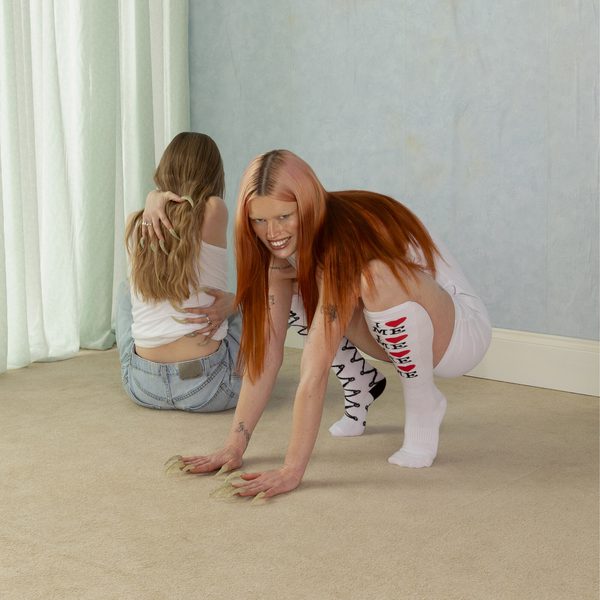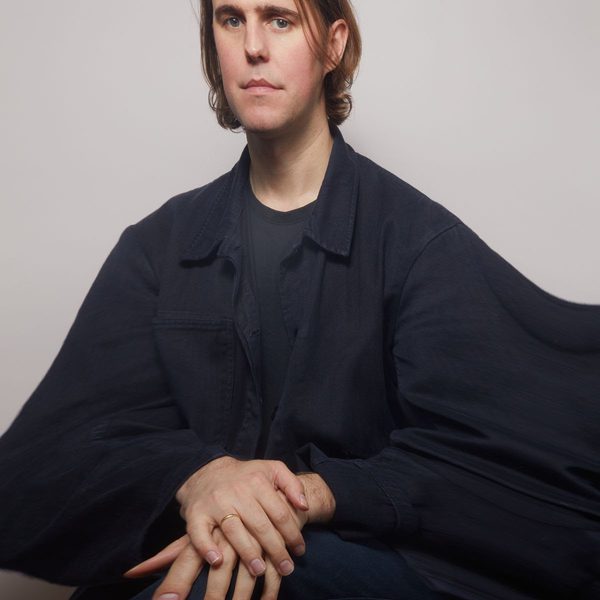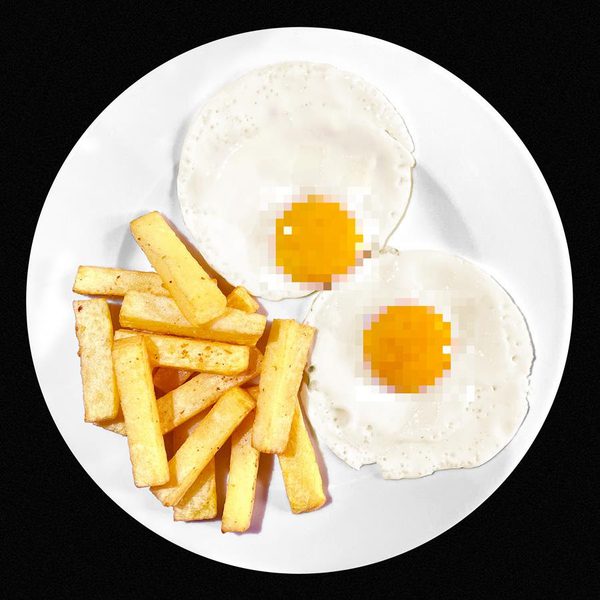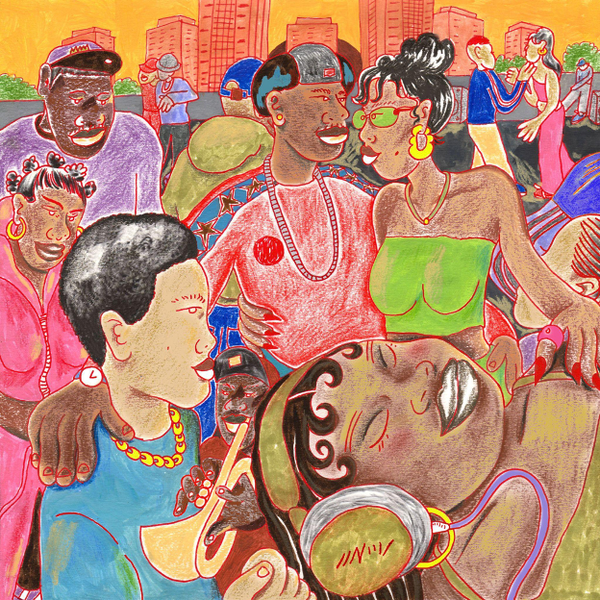
Bob Gruen: "Take a lot of pictures, pick out the good ones and just show the good ones"
A band is currently soundchecking in the Huntingdon Gallery, the location of noted rock and roll photographer Bob Gruen's current exhibition, Rock Seen, which also doubles as the setting for our interview. Though it makes recording our conversation somewhat difficult (we later relocate), it's actually quite refreshing to hear music being played out as an audio backdrop to the large catalogue of photos - which though not necessarily all focused on live performances, deal with countless musicians and icons. Where we end up moving to is also quite fitting; we retreat to a rather tight-fitting space between the gallery walls, much like the cramped backstage areas where many of Bob's famous pictures were captured.
Bob's first steps into photography were through his mother, it was her hobby, she taught him how to develop and print pictures from the age of four, after which he got his first camera, a Brownie Hawkeye at eight, and became the family photographer. He credits this as important training in his ability to "get five or six kinda dysfunctional people all together for the same time for a shot...[learning] how to capture situations and get people in a group to get over their inter-personal problems and just relate to me and relax". He's changed cameras many times through his career, including using Minolta, Kodak, Olympus, and Nikon; the digital Canon 5D MK III is one of his mainstays today - he notes this was his choice camera for a recent shoot with The Strypes ("It does more than my whole camera bag of equipment that I used to carry!"). One of the main things you realise when talking with Gruen is his calm, relaxed attitude. He mentions Yoko Ono told him this "made a big difference, that a lot of times when the photographer's nervous [the artist's] gonna be nervous... but I'm always pretty comfortable and so people are comfortable with me".
We begin by talking about his early work, which leads to his first official photo-pass, which was for the Newport Folk Festival in 1965 - the setting for that infamous 'electric set' from Bob Dylan.
"I managed to talk my way into a photo-pass – they told me no about ten times and I asked about twelve and finally got the pass. And so I was down front, I wasn't working for anybody, I didn't have an assignment, I was taking pictures but had nowhere to send them. Actually, a couple of weeks later, I brought a couple of pictures to Bob Dylan's office, and left them with the receptionist. She came back and said that Bob had liked them and they gave me a ticket to an upcoming concert, but they were never published. More recently I've been actually in touch with his management about using my pictures."
 What was it like seeing that infamous set?
What was it like seeing that infamous set?
"Well, people say that they booed when Bob Dylan came on with the band, but he wasn't the first person to play with an electric guitar, but it was the sound of the music, the speed and the volume, and the intensity...a lot of the people wanted calm, folk music and they wanted to hear 'Blowin' in the Wind' and 'We Shall Overcome' and suddenly 'I ain't gonna work on Maggie's Farm no more' came on and it kinda blew them away. But other people liked it, so it wasn't just booing – it was booing and cheering, and people were yelling at each other, like 'what the fuck you talking about?' and 'shut the fuck up!' back and forth, so it was this kinda roar that came up out of the crowd. There were a lot of boos which he wasn't used to, but just the intensity of the reaction – and it was interesting because I never saw that reaction again, until another Bob Dylan tribute concert in Madison Square Garden where there was like 30 different top acts – Johnny Cash, Eric Clapton, all these people, Neil Young, doing Bob Dylan songs, and Sinead O'Connor came out, and it was about a week after she'd ripped up that picture of the Pope, so she was quite controversial, and some people really thought that was great, but other people hated her for it. So, she came out and instead of a Bob Dylan song, she started singing a Bob Marley song, and the audience erupted just as she started when they didn't know what she was singing and they saw her, and people were cheering and people were booing and people were yelling at each other. It was startling to me as I hadn't heard that sound in thirty years."
When you were there, shooting Bob, did you get any reaction to how he felt when it happened?
"He definitely reacted. I have a great picture where he looks like a rock and roller, not a folk singer, and it was a transformation, and I liked it. After a few numbers with so many people yelling, he went off the stage after about five songs, and he was sitting backstage, physically upset, with Pete Seeger telling him 'take the acoustic guitar and go back and do an encore and be the Bob Dylan they expect'. He kind of came out and sang 'It's All Over Now, Baby Blue' and then he sang a hit or two - cos' you know, you gotta make a buck, please the crowd - but yeah, he was visibly upset. He's a real person. To me, he was making a statement that the folk music of America was rock and roll, and folk music was supposed to be the music of the people, and by '65 rock and roll was the music of the people and so that's kind of the statement he was making, which I admire a lot." I saw him a couple of weeks later at Forest Hills – a concert where I went out and said 'spare ticket' in front of the theatre and I got a good box seat straight across from the stage – it was a tennis stadium, so they had big tennis courts between the stage and the audience, it was a big distance. The first set – he did an acoustic set, and then he came back with the band, and at one point during the second set with the band, some kid jumped out of the audience and went running across the tennis court and guards came out from the side towards him. They were closing in and he jumped up on the stage and went right up to Dylan and put his hand out to shake hands, and I have this indelible picture in my mind of Dylan standing there playing, kinda looking at him like 'What do you expect me to do?', and the kid is standing there going 'Ah, Bob Dylan!' and the guards were closing in, so he jumped off in the other direction and ran full speed towards the exit door. Just before he gets to the exit door, a guard pushed him sideways and he smashed into the wall - I've heard a bootleg of the concert and you can hear as the audience starts to cheer for this kid, and then there's this moment of cheering and all of a sudden the whole audience goes 'ooohhh' as he hits the wall."
Tina Turner spinning through multiple exposures is easily one of my favourite images of Bob's, and he was keen to talk about how it came about.

"A friend of ours convinced us we had to go see Ike and Tina Turner - they were amazing, so we went to the show and I was floored. She is unique and phenomenal and wild, she dances off the stage to a strobe light...and I remember looking back at the curtain where Tina had disappeared and not really watching [the main act] after. So they played a couple of days later and I brought my camera. I remember sitting on the floor of this funky place, the Honka Monka, on Queens Boulevard – and taking some pretty good pictures of the show. Then at the end, there was the strobe light, and I wondered what would happen if I opened the camera for a second - I took about four or five frames, the other three or four were no good, they're just all over the place - I had no idea where to focus, no idea what the timing was, I had no idea what the exposure was. One frame came out just perfect – and I caught five images of Tina in the one frame, and that's what she does in one second."
That incredible energy...
"...is all caught. It's one of those things – 'Did you ever know when you develop a picture it was good?' I saw it in the contacts and I thought it was ok, and as it came out in the developer I remember the moment going 'Holy Mackerel!' I made a good picture here'. They would play around the area when they were in town, so we went to New Jersey a couple of days later and I brought the pictures with me to show my friends. On the way out, the dressing rooms were trailers outside, and my friend saw Ike Turner walking from one trailer to another and she literally pushed me in front of Ike and said, "Show Ike the pictures!" He stopped and said 'What pictures?' and I said 'Well I have these pictures' and he said "These are pretty good, come here, I gotta show these to Tina," and he brought me into the dressing room. The next thing I know is I'm talking to Tina Turner herself and she's liking my pictures, and I'm having trouble breathing. He said he was going to bring me to the record company next week and I should get in touch. A couple of days later they played at the Newport Jazz Festival – one of my all time favourite concerts – Kenny Burrell, Ross and Roland Kirk and Ike and Tina Turner – so we had a nice dinner on the lawn during Kenny Burrell. Rahsaan Kirk is one of my favourites – he's like a rock and roll saxophonist – they call him jazz but he rocks, and then Ike and Tina Turner on a summer night – it was beautiful. And then we got back in the car to go home...I pulled into the first rest stop to get a cup of coffee, I pulled in and got out of the car, and two limousines right then pulled up next to me, and I was standing there going "I wonder who this is?" and Ike and Tina and the band get out – and they recognised me "You the guy from last night?" and I said 'I just saw the show at Newport' – 'Come on in and have breakfast with us', so I started meeting them. And so people ask me, how did I do this and it's just my path, it's just what I did."
I know you did one of Ike & Tina's album covers...
"Before the year was out they took me out to California for the week to do that. It was Nuff Said and they left my name off it. And when I first saw it I said 'You didn't put my photo credit' and they said 'Don't worry kid, next printing we'll take care of it' – well, that never happens. It's not even on the CD, and it was funny, because I made the print...I'd been out there for a week, I came home on the red-eye, because we met the art director in California on Friday and he said bring these to me Monday morning. So I flew home the next morning, developed pictures for a day and a half, made that print around 5 in the morning, met him at 8am Monday morning and he liked that one, and I said 'well I'll make you a better print' and he goes 'nah this is fine', and said 'no, I'll make a good print' and he said 'we'll fix it, don't worry about it' – well they didn't fix it, it's hazy, it works actually, and that really opened a lot of doors. I met publicists for the record company, he introduced me to a couple more people, Jane Friedman who eventually managed Patti Smith, she was bringing bands over, she was a promoter, to the Hurrah club, bringing over a lot of English groups. So, I just started meeting more and more people – Marv, the publicist at UA, took me a party - the same party where I met Billy Smith - a publicist who worked for MCA Records. He hired me to do a brand new up and coming piano player just over from England, opening for Leon Russell, called Elton John. So I met him on his first trip to New York and he liked the pictures I did, I worked for him for the next couple of years. The connections just happened, I worked very hard, in spite of the fact that I did all of this to avoid working, and doing what I enjoyed doing, I worked very hard, because you had to get the pictures developed, you had to get them to the magazine, you had to do it right away or you get a backlog, and it builds up, and besides, back then it was news and you had to get it right out, or do something else."

Speaking of iconic moments, the Blondie moment with the car – was that real, or a set?
"Nowadays you'd have to pay half a million dollars to do that. It's a little upsetting to me, as it was actually a horrific accident on 6th Avenue, and I used to ride my bike around the city and it was a car upside down on 6th Avenue, so something terrible had happened. It was there for a couple days, and a couple of days later when I went to see Blondie doing their first demo record, which at the time was so unimportant – with a lot of CBGBs bands there was a phrase that was very common 'No Commercial Potential' – these bands were bad, playing funny songs, and there wasn't commercial potential. So I didn't take any pictures in the studio, but coming out of the studio with the band, I think it was Chris who said "let's take a picture by that wreck". I thought it was a little bit of a sacrilege, but Chris stuck the guitar into the wreck like it was falling out, and Debbie, being the personality she is, actually crawled into the car, and came crawling out like it was her car accident. So it was very spur of the moment, we probably took about ten frames, a few colour a few black and white and we were done, it was just a joke. But, now it's kind of an iconic moment, but recreate that today? To create that kind of moment, first you got to have someone think it up, and then you have to pay for a wreck and put it somewhere, and get stylists and catering and it would be very different. But that was real, a horrible accident."
Though with the Blondie example he only took a small number of frames, we briefly discuss how he goes about selecting his pictures. He mentions he'd pre-select the best pictures even with physically submitting them to editors, putting 'the contacts inside an envelope inside the envelope with the pictures, so when [editors] opened it and pulled it out all they saw were the six pictures they needed and they didn't have to bother going through the contacts". As such, it's unsurprising that his main tip to any aspiring music photographers also follows this mantra: "take a lot of pictures, pick out the good ones and just show the good ones. Only show good pictures - people think you're good". I go for another walk around the gallery before I leave, and though I'm now equipped with some background knowledge to the how, why and where of the many hanging pictures, I don't necessarily feel much more of an insider, as Bob, with his relaxed, intimate approach, has already afforded any viewer of his work a surprisingly personal connection with the artists captured.
Bob Gruen's photography exhibition, Rock Seen, is currently at the Huntingdon Gallery in Shoreditch until 27 October.
Get the Best Fit take on the week in music direct to your inbox every Friday

Wet Leg
moisturizer

MF Tomlinson
Die To Wake Up From A Dream

BIG SPECIAL
National Average





